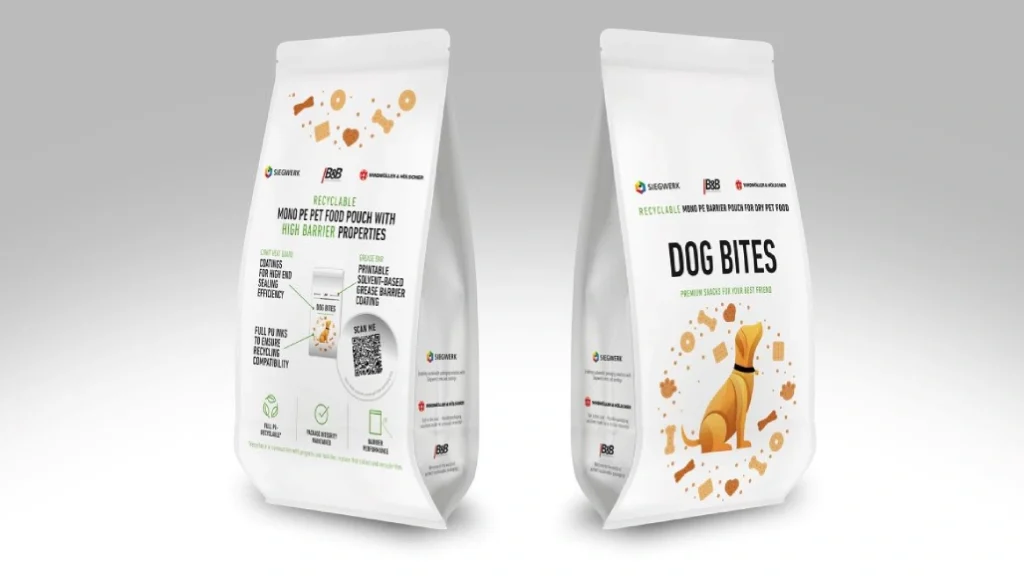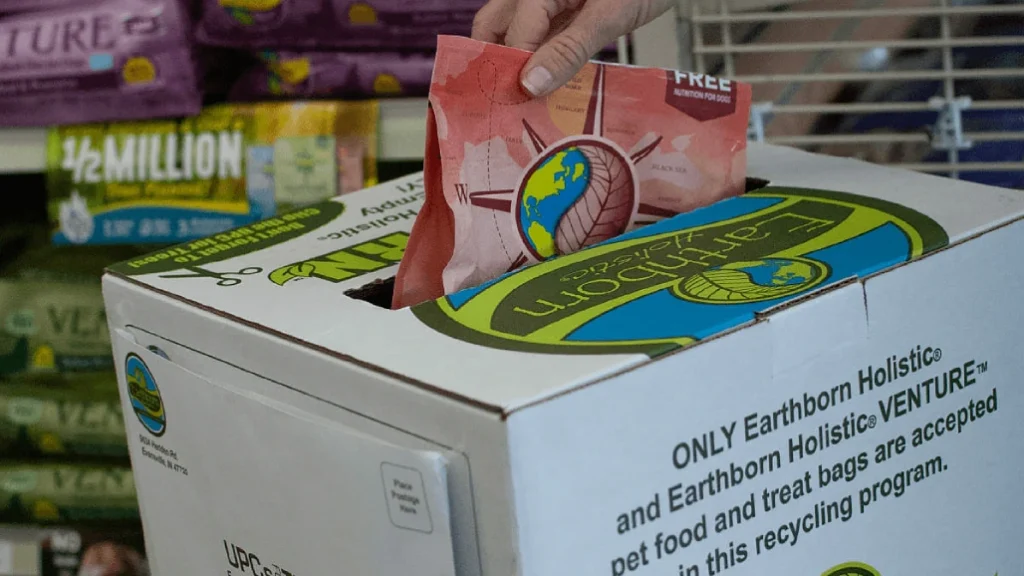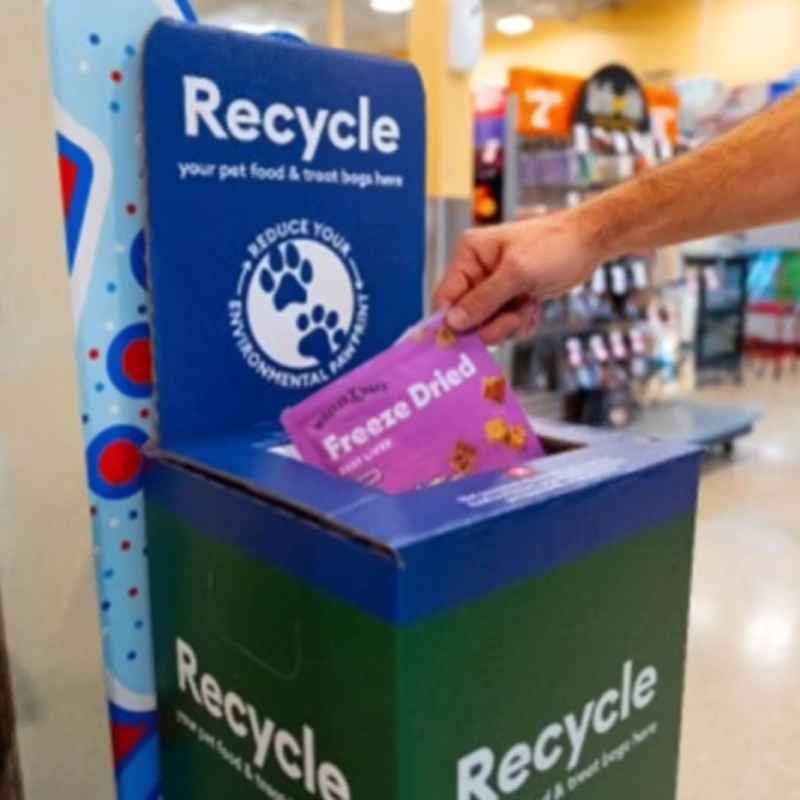Pet food pouch recycling has become an essential part of environmental sustainability as the use of pet food pouches continues to grow.
With millions of households owning pets, the environmental impact of discarded packaging cannot be overlooked.
Today, we will explore the current state of pet food pouch usage, the challenges and opportunities for recycling, and actionable steps for creating a greener future.
If you have any questions about the content, feel free to contact us.
What is a Pet Food Pouch ?

The pet food industry has seen remarkable growth, driven by increasing pet ownership and the demand for convenient feeding options.
Pet food pouches have gained popularity due to their lightweight, easy-to-use design, and ability to preserve freshness.
Popular brands such as Pet Pride cat food pouches and Peter Rabbit food pouches are just a few examples of the extensive options available.
However, this convenience comes at a cost to the environment, as millions of pouches are discarded daily.
Diverse Materials of Pet Food Pouch
BN Pack has seen firsthand the wide range of materials used in pet food pouches. The most common materials include plastics, aluminum foils, and composite materials.
Plastics, such as polyethylene (PE) and polypropylene (PP), are popular for their flexibility and cost – effectiveness. Aluminum foils are often used to provide a barrier against light, oxygen, and moisture, ensuring the freshness of the pet food.
Composite materials, which combine different layers of plastics, foils, and papers, offer a combination of properties, such as strength, barrier protection, and printability.
However, this diversity in materials also poses challenges when it comes to recycling. For example, separating the different layers in composite materials can be extremely difficult and requires advanced technology.
Large-Scale Usage of Pet Food Pouch
The scale of pet food pouch usage is staggering. Every day, millions of pet food pouches are used around the world. In the United States alone, with its large pet – owning population, the number of pet food pouches discarded daily is in the hundreds of thousands.
This not only takes up valuable landfill space but also contributes to environmental pollution.
Why Pet Food Pouch Recycling is Important?

Pet Food Pouches Recycling for Environmental Protection
One of the primary reasons for pet food pouch recycling is environmental protection. When these pouches end up in landfills, they can take hundreds of years to decompose.
Plastics, in particular, break down into microplastics over time, which can contaminate soil, water sources, and even enter the food chain.
By recycling pet food pouches, we can reduce the amount of waste in landfills and prevent the release of harmful pollutants into the environment.
Pet Food Pouches Recycling for Conservation of Resources
Recycling pet food pouches helps conserve valuable resources. The production of new packaging materials requires a significant amount of energy and raw materials.
By recycling, we can reuse these materials, reducing the need for virgin materials extraction. For example, recycling plastic pouches can save oil, which is a non – renewable resource used in plastic production.
Pet Food Pouches Recycling for Cost – Efficiency in the Long Run
For pet food manufacturers, recycling can lead to cost – savings in the long term. Using recycled materials in packaging production can be more cost – effective than relying solely on virgin materials.
Additionally, as environmental regulations become more stringent, companies that engage in sustainable practices like recycling may avoid potential fines and penalties.
Challenges in Pet Food Pouch Recycling

Complex Material Composition
As mentioned earlier, the complex materials used in pet food pouches make recycling a challenging task. Separating different layers in composite materials requires specialized equipment and techniques.
For instance, in a pouch that combines plastic, aluminum foil, and paper, separating these materials without causing damage to them is difficult.
Currently, many recycling facilities are not equipped to handle such complex materials, which often leads to these pouches being sent to landfills instead.
Low Public Awareness
Another significant challenge is the low level of public awareness regarding pet food pouch recycling. Many pet owners are simply unaware that these pouches can be recycled.
They may toss them in the regular trash without a second thought. In some cases, even when people are aware of recycling, they may not know the proper procedures for recycling pet food pouches.
Inadequate Recycling Infrastructure
The recycling infrastructure for pet food pouches is currently insufficient. There are limited recycling facilities that accept these pouches, and the collection systems are often not well – developed.
In many areas, there are no dedicated collection points for pet food pouches, and they are not included in the regular curbside recycling programs. This lack of infrastructure makes it difficult for pet owners to recycle their pouches even if they want to.
Feasible Strategies of Pet Food Pouch Recycling

Step-by-Step :Pet Food Pouch Recycling Process
Step 1: Collection
We believe that the first step in recycling pet food pouches is to improve the collection process. Supermarkets and pet stores can play a crucial role in this. They can set up collection bins at their entrances or near the checkout areas.
BN Pack has seen some stores that have successfully implemented this strategy. Customers can drop off their used pet food pouches in these bins, and the stores can then arrange for regular pick – up by recycling companies.
Step 2: Sorting
Once the pouches are collected, they need to be sorted according to their materials. This is a critical step as different materials require different recycling processes.
Automated sorting machines can be used to separate plastics from foils and papers. However, in some cases, manual sorting may still be necessary, especially for complex composite materials.
Step 3: Cleaning and Processing
After sorting, the pouches need to be cleaned to remove any remaining pet food residue. This can be done through a series of washing and sanitizing processes.
Once clean, the materials can be processed further. For example, plastics can be melted down and reformed into new plastic products, while aluminum foils can be melted and recast.
Promoting Public Awareness
Step 1: Educational Campaigns
We’ve found that educational campaigns are essential for increasing public awareness. We can partner with pet – related organizations, schools, and community groups to organize educational events.
These events can include workshops on recycling, where pet owners can learn about the importance of recycling pet food pouches and the proper recycling methods.
Step 2: Social Media and Online Resources
In today’s digital age, social media and online resources are powerful tools. We can create engaging content, such as infographics, videos, and blog posts, that explain the recycling process and the benefits of recycling pet food pouches.
Sharing these resources on platforms like Facebook, Instagram, and Twitter can reach a wide audience.
Strengthening Pet Food Pouch Recycling Infrastructure
Step 1: Collaboration with Recycling Companies
We need to collaborate with recycling companies to expand the recycling infrastructure. This can involve investing in new recycling technologies and facilities that can handle pet food pouches.
For example, some recycling companies are developing new techniques to separate composite materials more efficiently.
Step 2: Government Support
We also advocate for government support in the form of policies and incentives. Governments can provide subsidies to recycling companies that invest in pet food pouch recycling infrastructure.
They can also enforce regulations that require pet food manufacturers to take responsibility for the recycling of their packaging.
Points to Note for Recycling Pet Food Pouches
Material Compatibility
When recycling pet food pouches, it’s important to note that not all materials are compatible with the recycling process. Some pouches may contain additives or coatings that can interfere with the recycling process.
Pet owners should check the packaging for any recycling – related symbols or instructions. If in doubt, they can contact the manufacturer or local recycling facilities.
Cleaning the Pouches
Before recycling, pet food pouches should be thoroughly cleaned. Residual pet food can contaminate the recycling stream and make it difficult to recycle the materials.
A simple rinse with water can usually remove most of the food residue.
Conclusion
Recycling pet food pouches is a critical step toward reducing waste and promoting sustainability in the pet industry.
By understanding the challenges, participating in recycling programs, and advocating for change, we can make a significant impact.
If you are interested in our packaging products or want to learn more, please visit our website or request a product catalog.
FAQs About Pet Food Pouch Recycling
Are pet food pouches recyclable?
Yes, pet food pouches are recyclable, but their multi-layered composition requires specialized recycling programs like TerraCycle.
Which supermarkets recycle pet food pouches?
Many supermarkets now partner with recycling initiatives. Check with stores like Tesco, Sainsbury’s, or Walmart for their recycling options.
Can you put cat food pouches in the recycling bin?
In most cases, cat food pouches cannot be placed in regular recycling bins due to their material complexity. Specialized programs are usually required.
How to recycle pet food packaging?
Step 1: Clean the pouches thoroughly. Step 2: Collect them in a separate bag. Step 3: Drop them off at a recycling center or mail them to programs like TerraCycle.
What is TerraCycle pet food pouches recycling?
TerraCycle is a program that accepts used pet food pouches for recycling. Participants collect pouches, ship them to TerraCycle, and contribute to reducing waste effectively.
Where to buy pet food pouches?
You can customize and purchase high-quality pet food pouches from us, BN Pack. We offer a full range of packaging solutions. Contact us anytime!
